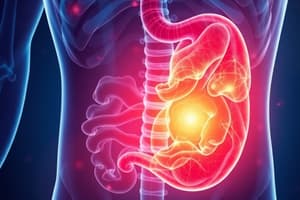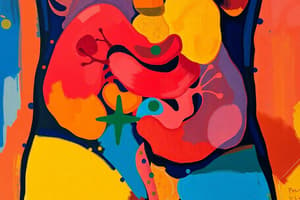Podcast
Questions and Answers
Which of the following conditions is typically associated with pain in the right upper quadrant?
Which of the following conditions is typically associated with pain in the right upper quadrant?
- Mesenterialer Verschluss
- Appendicitis
- Sigmadivertikulitis
- Cholecystitis (correct)
Pain from appendicitis always starts in the right lower quadrant.
Pain from appendicitis always starts in the right lower quadrant.
False (B)
What is the most common location for pain associated with acute diverticulitis?
What is the most common location for pain associated with acute diverticulitis?
left lower quadrant
Pain from reflux esophagitis is typically located behind the ______.
Pain from reflux esophagitis is typically located behind the ______.
Match the following conditions with the typical location of pain:
Match the following conditions with the typical location of pain:
A patient presents with periumbilical pain that later migrates to the right lower quadrant. Which condition is most likely?
A patient presents with periumbilical pain that later migrates to the right lower quadrant. Which condition is most likely?
Myocardial ischemia can sometimes present with upper abdominal pain.
Myocardial ischemia can sometimes present with upper abdominal pain.
What type of pain is typically associated with gastroenteritis?
What type of pain is typically associated with gastroenteritis?
A ruptured abdominal aortic aneurysm typically presents with pain around the ______ area.
A ruptured abdominal aortic aneurysm typically presents with pain around the ______ area.
Which of the following conditions is least likely to cause pain in the left upper quadrant?
Which of the following conditions is least likely to cause pain in the left upper quadrant?
Esophageal pain is exclusively felt in the chest and never radiates to the back.
Esophageal pain is exclusively felt in the chest and never radiates to the back.
In addition to abdominal pain, list two common symptoms of Morbus Crohn?
In addition to abdominal pain, list two common symptoms of Morbus Crohn?
Pain associated with kidney stones is often described as ______ and may radiate to the groin.
Pain associated with kidney stones is often described as ______ and may radiate to the groin.
Which of the following is a risk factor for developing diverticulitis?
Which of the following is a risk factor for developing diverticulitis?
All patients with Morbus Crohn experience the same symptoms and the same severity.
All patients with Morbus Crohn experience the same symptoms and the same severity.
Flashcards
Appendizitis
Appendizitis
Entzündung des Wurmfortsatzes, oft durch bakterielle Infektion oder Verstopfung verursacht.
Ileus (Darmverschluss)
Ileus (Darmverschluss)
Ein Verschluss des Darms, der mechanisch oder durch Lähmung verursacht sein kann.
Morbus Crohn
Morbus Crohn
Eine chronisch-entzündliche Darmerkrankung, die den gesamten Verdauungstrakt betreffen kann.
Gastroenteritis
Gastroenteritis
Signup and view all the flashcards
Refluxösophagitis
Refluxösophagitis
Signup and view all the flashcards
Mesenterialinfarkt
Mesenterialinfarkt
Signup and view all the flashcards
Divertikulitis
Divertikulitis
Signup and view all the flashcards
Schmerzen im rechten oberen Quadranten
Schmerzen im rechten oberen Quadranten
Signup and view all the flashcards
Epigastrische Schmerzen
Epigastrische Schmerzen
Signup and view all the flashcards
Schmerzen im linken oberen Quadranten
Schmerzen im linken oberen Quadranten
Signup and view all the flashcards
Schmerzen im rechten unteren Quadranten
Schmerzen im rechten unteren Quadranten
Signup and view all the flashcards
Periumbilikale Schmerzen
Periumbilikale Schmerzen
Signup and view all the flashcards
Schmerzen im linken unteren Quadranten
Schmerzen im linken unteren Quadranten
Signup and view all the flashcards
Rovsing-Zeichen
Rovsing-Zeichen
Signup and view all the flashcards
McBurney-Punkt
McBurney-Punkt
Signup and view all the flashcards
Study Notes
Anamnese & Untersuchung – Schmerzlokalisation
- The image presents a diagram illustrating the likely locations of pain associated with various medical conditions in the abdominal area.
Right Upper Quadrant
- Gallstone ileus (Gallenkolik) can manifest with pain in this area.
- Cholecystitis, or inflammation of the gallbladder, is a potential cause of discomfort.
- Choledocholithiasis, involving gallstones in the common bile duct, may lead to right upper quadrant pain.
- Cholangitis, an infection of the bile duct, presents a risk.
- Peptic ulcers can sometimes cause referred pain to this region.
- Hepatitis, commonly known as liver inflammation.
- Liver tumors (Neoplasma der Leber) and liver abscesses can both induce pain.
- Pneumonia or lung infection.
- Pneumothorax or collapsed lung.
- Subphrenic abscess, or collection of pus beneath the diaphragm.
- Pyelonephritis is a kidney infection.
- Nephrolithiasis is kidney stones.
- Colitis or colon inflammation, and finally, Herpes Zoster, or shingles.
Epigastric Region
- Peptic ulcers may result in pain in the epigastric region.
- Duodenitis, is inflammation of the duodenum.
- Pancreatitis an inflamed pancreas.
- Gastroenteritis, is inflammation of the gastrointestinal tract.
- Mesenteric adenitis, is inflamed mesenteric lymph nodes.
- Inflammatory bowel disease (entzündliche Darmerkrankung).
- Mesenteric occlusion, or blockage of blood flow to the mesentery.
Left Upper Quadrant
- Peptic Ulcer
- Splenic infarction
- Splenic rupture
- Pancreatitis
- Pancreatic neoplasm
- Pneumonia
- Pulmonary embolism
- Pneumothorax
- Subphrenic abscess
- Pyelonephritis
- Nephrolithiasis
- Colitis
- Myocardial ischemia
- Herpes zoster
Right Lower Quadrant
- Appendicitis is inflammation of the appendix.
- Inflammatory bowel disease is a chronic inflammation of the digestive tract.
- Ovarian tumor
- Tubo-ovarian abscess: Abscess involving the fallopian tube and ovary.
- Twisted ovarian cyst (stielgedrehte Ovarialzyste).
- Ovarian torsion.
- Salpingitis is inflammation of the fallopian tubes.
- Ectopic pregnancy a pregnancy outside womb.
- Hernia is a bulge protruding through muscle.
- Pyelonephritis
- Nephrolithiasis
Periumbilical Region
- Early stages of Appendicitis
- Small bowel obstruction.
- Gastroenteritis.
- Ruptured abdominal aortic aneurysm (BAA-Ruptur).
- Dissection of the abdominal aorta.
- Mesenteric ischemia is insufficient blood flow to the small intestine.
- Hernia.
Left Lower Quadrant
- Sigmoid diverticulitis is inflammation of the diverticula in the sigmoid colon.
- Inflammatory bowel disease is a chronic inflammation of the digestive tract.
- Ovarian tumor
- Tubo-ovarian abscess: Abscess involving the fallopian tube and ovary.
- Twisted ovarian cyst (stielgedrehte Ovarialzyste).
- Ovarian torsion
- Salpingitis is inflammation of the fallopian tubes.
- Ectopic pregnancy is a pregnancy outside womb.
- Hernia
Referred Pain Localization
- Diaphragm pain (C4 dermatome).
- Gallbladder pain refers to the upper right abdominal area.
- Heart pain refers to the chest and left arm (Th3 + 4 dermatomes).
- Esophageal discomfort refers to the mid-chest area (Th4 + 5 dermatomes).
- Stomach pain around the upper abdomen (Th8 dermatome).
- Liver and gallbladder pain can be felt in the right upper quadrant (Th8-11 dermatomes).
- Small intestine discomfort circles around the umbilicus (Th10 dermatomes).
- Large intestine pain is around the lower abdomen (Th11-L1 dermatomes).
- Urinary bladder pain may be located in the suprapubic region (Th11-L1 dermatomes).
- Kidney and testicle discomfort is generally located around the flank and groin (Th10-11 dermatomes).
Appendicitis
- Rovsing's sign: Pain in the right lower quadrant upon palpation of the left lower quadrant
- McBurney's point: Tenderness located one-third of the distance from the anterior superior iliac spine to the umbilicus
- Blumberg sign: Rebound tenderness (pain upon release of pressure) in the right lower quadrant.
- Lanz point: Point located on the line between the anterior superior iliac spines
- Spina iliaca is a bony projection of the ilium
- Nabel refers to the umbilicus
Appendicitis
- Bacterial infection: Originates in the intestines and spreads to the appendix.
- Blockage: Occurs from foreign objects (like cherry pits) or hardened stool (especially with constipation) obstructing the appendiceal lumen.
- Symptoms: Intensifying abdominal pain starts near the navel or upper abdomen, shifting later to the lower right abdomen.
- Characterized by a throbbing or drilling sensation.
- Fever
- Nausea and vomiting
- Cold sweats
Ileus = "Darmverschluss" (Intestinal obstruction)
- Mechanical: Indicates physical blockage of the intestinal lumen.
- Paralytic: Loss of peristalsis.
- Mechanical: Obstruction caused by hindrance of the normal passage in the intestine - build up of hardened stool, scar tissue, or foreign objects.
- Compression or twisting of the intestines, tumors, scar tissue, and hernias.
- Symptoms: Constipation, bloated abdomen, colicky abdominal pain, nausea or vomiting
- Paralytic: Reduced bowel movement, severe abdominal inflammation, mesenteric artery infarction, hypokalemia, medications, metabolic disorders, and nerve disorders
- Symptoms: Nausea or vomiting, distended abdomen, and absence of bowel sounds.
- Common sites for obstruction are the distal small intestine (2/3) and the colon (1/3).
- Pain description: Colicky, with wave-like cramping.
Morbus Crohn (Crohn's Disease)
- Risk markers: Hereditary, smoking, imbalance in flora, environmental influence, existing inflammation, mucosal damage.
- Symptoms: Abdominal pain, diarrhea, fever, anemia, loss of appetite, weight loss, fatigue
- Pain described as dull, cramping, or colicky
- Pain linked with food intake or bowel movements
- The most common location is the lower right abdomen
Gastroenteritis
- Pathophysiology: Varies depending on the organism, includes, bacterial, viral, stress, or deslaminases
- Distinct age groups affected
- Symptoms include: Upper abdominal pain, nausea, vomiting, diarrhea, lack of appetite, and bloating.
- Localized to the epigastric (upper middle) area.
- Pain is cramping, dull/pressing, or colicky.
Refluxösophagitis (acid reflux)
- Causes: Stress, fatty foods, coffee, alcohol, smoking, increased abdominal pressure, and a weakened sphincter.
- Symptoms: heartburn, acid reflux, difficulty swallowing, hoarseness, chronic cough.
- Pain behind the breastbone or in the upper abdomen or back.
- Burning sensation, pressure
- Symptoms worsen after eating or lying down
Mesenteric Infarction
- Development: Ischemia caused by arterial thrombosis or embolism
- Risk factors: AFib, endocarditis, birth control, heart issues
- Symptoms: Abdominal pain, diarrhea, peritonitis
- Difficult to locate
- Pain described as diffuse and colicky or crampy
Diverticulitis
- Development: Inflammation of the diverticula caused by genetic factors that cause weakening of the colon wall.
- Risk Factors: Advanced age, low-fiber diet, genetic problems or motility disorders
- Presents as left side problems can show up on the right size
- Divertikel are usually with the colon sigmoudeum
- Pain is acute and increases with movement
Studying That Suits You
Use AI to generate personalized quizzes and flashcards to suit your learning preferences.




